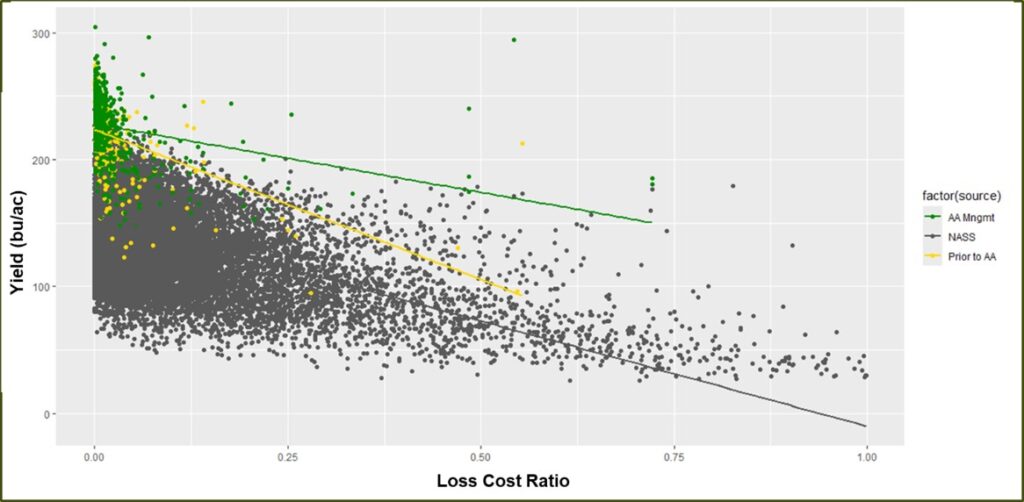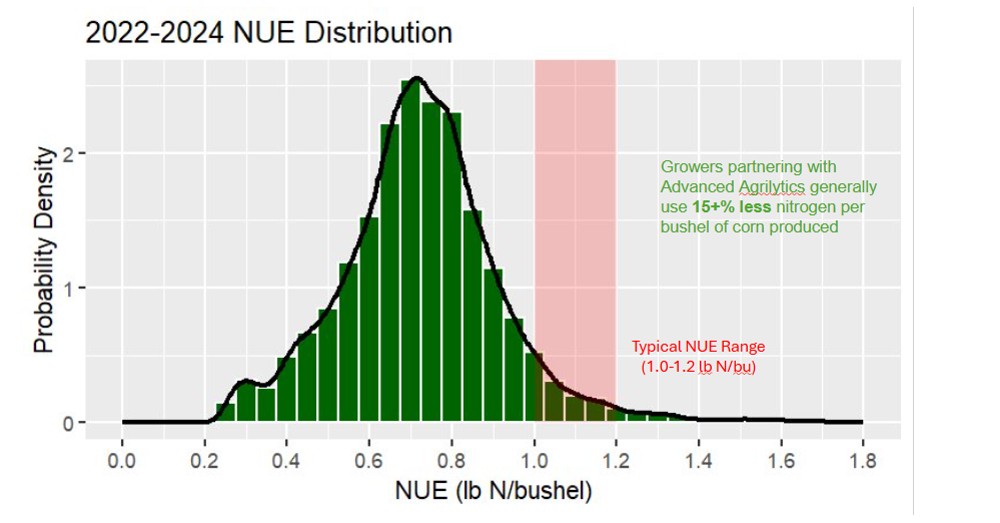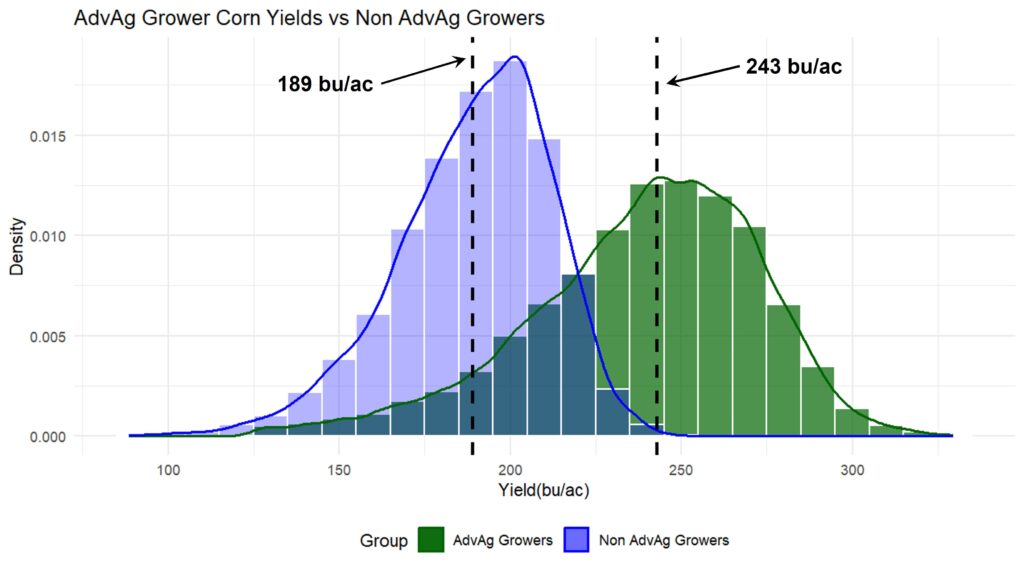New data shows that farmers working with Advanced Agrilytics experience lower loss risk than national benchmarks. Here’s why that matters more than ever.
If you like this article, you should check out our newest publication! Our white paper, "Transforming Global Food Production One Algorithm at a Time" has just been published.
When spring weather takes a turn—whether it’s delayed planting due to excess rain, or unexpected cold snaps that push back field prep—the effects ripple through the entire growing season. For row crop producers, every weather event increases exposure to financial and agronomic risk. But what if the right crop management strategy could reduce that exposure before the season even starts?
Recent findings from Advanced Agrilytics Chief Science Officer Jon Fridgen suggest just that. In a comparative analysis of USDA Risk Management Agency (RMA) loss cost ratio and internal performance data, Fridgen found that Advanced Agrilytics customers routinely experience lower loss risk across the board.
“We’re seeing our growers consistently outperform USDA benchmarks, even in years with significant weather pressure,” Fridgen said. “That’s not just luck—it’s the consequence of using our customized prescriptions that manage nutrients more efficiently, produce healthier, more productive plants and improve yield consistency across the whole farm, over time.”
Figure 1: Increased Resilience During Adverse Conditions

This scatter plot illustrates the relationship between yield performance and crop insurance loss cost ratios—the higher the ratio, the greater the insurance payouts due to yield losses. The trendline for Advanced Agrilytics customers (represented by the green dots and the green trend line) shows a much flatter decline compared to the RMA/NASS-reported average. This means that as weather variability or other risk factors increase, Advanced Agrilytics growers’ yields remain more stable.
Each dot and trend line tells a story:
- Green dots represent current Advanced Agrilytics customers with acres under active management. The green trend line shows that the rate of yield decreases is not as steep for Advanced Agrilytics customers.
- Yellow dots show the same growers before partnering with Advanced Agrilytics.
- Gray dots reflect the broader population of all farmers as reported by USDA National Agriculture Statistics Service (NASS), serving as a national benchmark.
While many farmers experience steep yield declines when risk increases, Advanced Agrilytics customers maintain a more resilient yield curve. The company’s data-driven management not only boosts productivity in good years—it helps growers better withstand tough seasons, reducing both agronomic and financial volatility.
A New Metric for Measuring Resilience
The RMA reports regional averages for loss cost ratios—a figure that shows the proportion of indemnified crop losses relative to insured value. It’s one of the clearest indicators of how risk-prone a farming strategy really is. The lower the ratio, the more resilient the operation.
When Advanced Agrilytics customers were compared to those regional averages, their performance was markedly better. That gap in loss cost ratio is more than a data point. It’s a signal of operational stability, increased resiliency, improved ROI, and long-term sustainability.
So how does the Advanced Agrilytics method create this “whole farm” resiliency?
Spatial Agronomy: Managing Risk at the Sub-Acre Level
Unlike traditional agronomy, which routinely takes a “cooking cutter” approach to nutrient management, often applying one uniform rate over an entire field (in some cases, over an entire farm), Advanced Agrilytics applies a spatial analysis methodology that identifies the unique characteristics of each sub-acre environment. This allows for tailored management strategies that reduce exposure to loss before the first seed hits the soil.
One key tool in that strategy: the proprietary Nitrogen Loss Layer, a predictive model that identifies sub-acre environments at risk for denitrification—the most common, weather-related nitrogen loss pathway. By integrating environmental data such as slope, organic matter, and water saturation (using the Soil Wetness Index), the Nitrogen Loss Layer classifies every part of the field according to its nitrogen loss potential.
The result? Targeted nitrogen application and stabilization strategies that avoid costly overapplication while protecting vulnerable acres. According to internal data, Advanced Agrilytics growers use 15% less nitrogen per bushel of corn produced compared to typical NUE benchmarks—without sacrificing yield.
Figure 2: Precision Nutrient Management Improves Nitrogen Use Efficiency

Turning Weather into an Advantage
This isn’t just a nitrogen story. Phosphorus and potassium management also play a key role in how resilient a crop is to environmental stress. Traditional nutrient recommendations assume a one-size-fits-all “critical level,” but Advanced Agrilytics uses a proprietary Spatial Critical Level algorithm that adjusts for water availability, soil texture, and topography, among other factors, at the sub-acre level.
Why does that matter? Because P and K are largely absorbed through diffusion—a process directly influenced by soil moisture. In wet years, nutrients can move freely; in dry years, diffusion slows, and yield suffers unless nutrient concentration is adjusted.
Research shows that there is a powerful correlation between water availability and diffusion:
| % Water (by Volume) | Gallons/A | Available Phosphorus/A (lbs.) |
| 25% | 47,520 | 0.086 |
| 13% | 24,706 | 0.045 |
| Conclusion: Almost double the amount of moisture in the soil leads to almost double the amount of available phosphorus | ||
The company’s spatial analysis methodology identifies high ground or low organic matter environments where water-limited conditions are likely. This enables precision, variable rate P and K applications that optimize nutrient uptake regardless of seasonal variability. On average, this results in higher nutrient use efficiency, more consistent yields, and less fertilizer waste—especially important as input costs remain volatile.
Resilience That Builds Over Time
While severe weather events grab headlines, the Advanced Agrilytics approach is designed for long-term risk reduction. Each season’s data is fed back into the patented TerraFraming™ platform, allowing Advanced Agrilytics analysis, agronomists and customers to see trends, adjust strategies, and build more resilient acres year over year.
In fact, fields that were historically low-yielding or prone to loss are now producing more consistently thanks to cumulative improvements in nutrient management, seed placement, and spatially guided in-season decisions.

The Bottom Line: Smarter Strategy, Lower Risk
For large-acre row crop growers navigating unpredictable spring conditions, weather is just one of many risks. Nutrient loss, ROI volatility, and inefficient input use can all erode profitability. But as Jon Fridgen’s analysis makes clear, a spatial data-driven approach to agronomy isn’t just a good idea—it’s a proven risk management strategy.
Whether it’s adapting to saturated soils in April or reallocating nutrients for a dry June, growers using Advanced Agrilytics’ methodology are making more informed decisions—and seeing more resilient outcomes.
As more growers seek ways to weather-proof their operations, those already working with Advanced Agrilytics offer a glimpse of what’s possible when agronomy meets precision. The numbers speak for themselves.